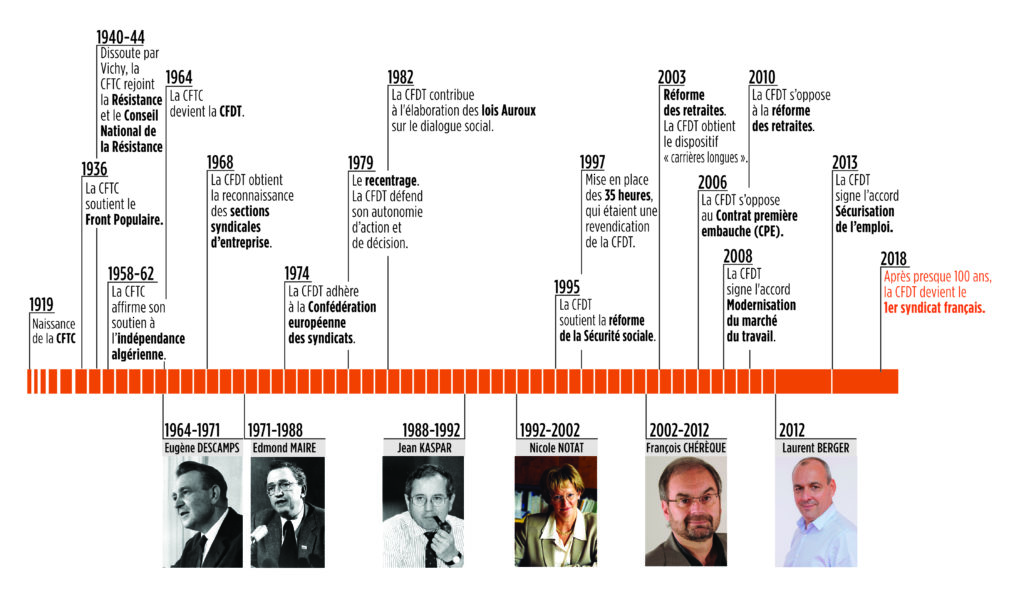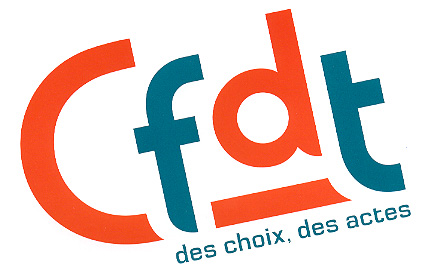
 1919: birth of the CFTC
1919: birth of the CFTC
The Confédération française des travailleurs chrétiens (CFTC) was founded in November. Inspired by the social doctrine of the Church, it organised itself on the basis of solidarity and the defence of workers’ interests against economic liberalism.
1936: The choice of the Front Populaire
At its congress in May 1936, the CFTC affirmed the validity of workers’ demands and urged its members to take part in the movement. The CFTC doubled its membership from 200,000 in early 1936 to 400,000 by the end of 1938. New militants from the JOC (Young Christian Workers) brought in new blood. Membership of the SGEN (Syndicat Général de l’Education Nationale), which had no Christian references in its statutes, was a vector for further change.
1940-1944: The CFTC in the Resistance
In 1940, the Vichy government decided to dissolve the trade union confederations. The three main leaders of the CFTC, along with nine CGT counterparts, published the “Manifesto of the Twelve” on 15 November 1940, the first expression of trade union resistance. Many CFTC leaders and activists took part in the Resistance. Gaston Tessier, the first general secretary of the CFTC in 1919, was a member of the CNR (National Resistance Council). In August 1944, a CGT-CFTC joint committee issued an order for an insurrectionary general strike and took part in the Liberation.
At the end of the war, the CFTC was recognised as a representative organisation alongside the CGT.
1958-1962: Democratic trade unionism and the Algerian war
As early as 1955, when the state of emergency in Algeria was voted through, the CFTC affirmed its support for the Algerian people. In 1958, the CFTC reiterated the right of peoples to self-determination and spoke out in favour of self-determination and peace in Algeria, as well as against any attack on democracy in mainland France. From 1960 onwards, it forged links with the Union Générale des Travailleurs Algériens (UGTA) to assist it in its fight for independence.
This led to a major realisation: trade unionism could not ignore politics if democracy and human rights were under threat; respect for these was a prerequisite for the existence of an independent trade union movement.
1964: the CFTC becomes the CFDT
The move towards secular trade unionism became a reality: on 6 November, the CFTC became the Confédération française démocratique du travail (CFDT) with 70% of the mandates. The current CFTC was formed from the minority that refused this democratic result.
1968: the CFDT obtains recognition of company union sections
Comparing its fight for democracy to that of employees in the workplace, the CFDT began supporting the student strike on 6 May. During the Grenelle negotiations, it won recognition for company trade unions. This was a fundamental achievement, as it led to the creation of company trade union sections.
1974: CFDT joins the European Trade Union Confederation (ETUC)
Keen to play an effective part in consolidating peace, the CFTC had been advocating the creation of a united Europe since the 1950s. The European Trade Union Confederation, a tool for trade union action at European level, was created in 1973.
1979: the CFDT defends its autonomy of action and decision-making (“refocusing”)
The CFDT refocuses on its mission as a trade union organisation to better respond to changes in society: globalisation, changes in the production system, restructuring and a sharp rise in unemployment.
1982: the CFDT contributes to the drafting of the Auroux laws on social dialogue
Inspired by CFDT proposals, the Auroux laws represented significant progress in the defence of employees’ rights and made major changes to labour law (prohibition of all forms of discrimination; obligation to negotiate collective agreements on pay, working hours and work organisation, and gender equality; development of staff representative bodies and creation of a right for employees to express their views on working conditions; creation of the Health, Safety and Working Conditions Committee – CHSCT).
1995: CFDT supports social security reform
In 1995, the CFDT supported the health insurance reform, which maintained the logic of a solidarity-based system by improving control of the healthcare system and extending its funding to all incomes.
1997: the CFDT negotiates the 35-hour working week
The CFDT’s key demand is the reduction of working hours. The CFDT entered into negotiations with the Jospin government to ensure that the 35-hour working week was synonymous with the creation of new jobs.
2003: CFDT obtains the “long career” scheme in the pension reform
Negotiated by the CFDT, this agreement enables 600,000 employees who started working early to retire before the age of 60.
2006: the CFDT opposes the Contrat première embauche (CPE – first job contract)
In 2006, the CFDT strongly opposed the “Contrat première embauche” (CPE). The CFDT’s involvement in this united movement was one of the major factors that caused the executive to back down and withdraw the project. One of the consequences of this was the adoption the following year of a law on the “modernisation of social dialogue”, which took up the CFDT’s demand for cross-industry negotiations prior to any changes to the Labour Code.
2008: the CFDT signs the agreement to modernise the labour market
The CFDT obtained new guarantees to make career paths more secure: certain rights, such as the right to company mutual insurance or training, became transferable after redundancy.
2010: CFDT mobilises against pension reform
The CFDT fights against the inequalities of the reform, which pushes back the statutory retirement age to 62 and tightens the conditions of the “long careers” scheme.
2012: Trade union general meeting
François Chérèque steps down as General Secretary and is replaced by Laurent Berger.
2013 : The CFDT signs the “job security” agreement.
In particular, the CFDT obtains the creation of the CPF (personal training account), which enables employees to receive training throughout their working lives, including when changing company.
2014: Marseille Congress
Laurent Berger is re-elected General Secretary.
2016: Compulsory supplementary health insurance in the private sector, at least 50% paid for by the employer.
This measure of the 2013 agreement came into force on 1 January 2016, providing :
– better access to healthcare for employees,
– more advantageous healthcare benefits thanks to the negotiated group contract,
– the opportunity to progress professionally by changing company, without fear of losing their health cover.
2017 : CFDT 1st in the private sector!
At the end of the second representativeness cycle, the CFDT becomes the No. 1 trade union organisation for private-sector employees.
2018 : The CFDT becomes France’s leading trade union
Following the various professional elections, the CFDT, already the leading union in terms of membership and the leading union in the private sector since 2017, becomes the most representative union in the public and private sectors as a whole, rewarding 100 years of trade unionism almost to the year.
2020 : The CFDT alongside workers during the Covid crisis
In a context of unprecedented global crisis, confinement or not, the CFDT remains mobilised to support workers and to put forward its demands so that no one is left by the wayside in this complex period. The CFDT reacted very quickly and obtained measures to protect workers in their workplace, to preserve their jobs and maintain their pay.
2021 : Extension of paternity leave to 28 days
This historic CFDT demand is a major social advance for all forms of parenthood. The challenge of equality between women and men requires better co-parenting, a better division of tasks, and better recognition, in society and in companies, of the responsibility and commitment of fathers.
2022 : The CFDT obtains the extension of supplementary health insurance
The CFDT has secured the extension of compulsory supplementary health cover to all three levels of the civil service: state, regional and hospital.
2023: “64 is a no! The CFDT opposes pension reform
The CFDT is opposed to raising the legal retirement age, which is an unfair, unjustified and brutal reform. An unprecedented mobilisation of millions of French men and women took to the streets during the 14 demonstrations. Despite all this, the government turned a deaf ear to the national mobilisation and rammed through its reform. The CFDT did, however, manage to secure a number of advances, including an increase in the minimum contributory pension, improved recognition of arduous working conditions, maintenance of the “long careers” scheme and the introduction of early retirement in the civil service.
2023: another woman at the helm of the CFDT
A new page in the history of the CFDT opened on 21 June 2023 at Le Zénith in Paris. After eleven years as General Secretary of the CFDT, Laurent Berger handed over to Marylise Léon, the new General Secretary, in front of 2,700 activists.

Marylise Léon succède à Laurent Berger
